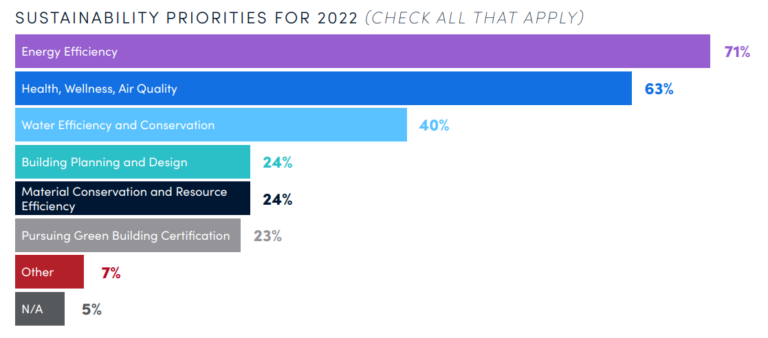Building operations in the United States account for roughly 40% of all energy consumption. It’s a big reason the commercial real estate (CRE) industry is increasingly focused on making sustainability efforts a top priority. And more government intervention is coming in the form of new legislation for sustainable construction practices and requirements such as energy certifications.
That means a sustainability strategy is no longer optional for property owners and operators.
It’s clear that CRE leaders will need to implement best practices for new construction, retrofitting existing buildings, and making strategic capital investments. With all told, creating a strategy for sustainable commercial real estate might seem daunting or expensive. But it doesn’t have to be. In fact, not having a sustainability strategy for your CRE portfolio or property could cost you a lot more. Here’s why.
Tenants Demand Sustainable Commercial Real Estate – You Need to Deliver
A survey of commercial property professionals conducted by Building Engines in partnership with the Building Owners and Managers Association International (BOMA) found that respondents’ top software investment priority in 2022 was directly related to the tenant experience.
Part of this demand is certainly organic, due to the pressing need to fill pandemic-related vacancies. However, according to the Building Engines/BOMA survey, the clear number two priority is energy management. Energy management is partly related to the tenant experience in the form of comfort and health and safety demands. And it has value for tenants and investors alike. Therefore, the top two overall priorities are tightly related.
The third and fourth priorities—overall building operations and equipment maintenance—directly impact energy management.
In other words, the top four priorities of survey respondents are all tied together and indicate sustainable commercial real estate has become incredibly important to the industry.
Notably, the survey also found that among sustainability priorities specifically, 71% of respondents indicated that energy efficiency was their top concern. Health, wellness, and indoor air quality was the second largest priority (63%), and water efficiency and conservation was the third (40%).
Sustainable Commercial Real Estate Drives Value
Even as external pressure is driving change and creating new challenges for the CRE market to overcome, it’s also creating opportunities for investors and owners. Those who meet these expectations proactively will succeed. It’s crucial to understand the current CRE landscape and the many ways of solving pain points while balancing ROI.
Green buildings are attractive to investors and tenants alike. That means they’re increasingly valuable. The clearest and simplest way to signal that your portfolio is green is to achieve industry certifications for your buildings. There are several such certifications, such as Energy Star, LEED, and GRESB. Achieving those certifications requires actionable steps, including evaluation, renovations, and upgrades, and capital investment planning for both. And technology can play a large role at all steps in the process.
CRE Tech Helps Leverage Today’s Biggest Sustainability Opportunities
There is no choice but to face the current and future climate change-induced sustainability challenges. CRE leaders must begin to do things differently in their buildings. Energy usage must decrease, and efficiency must improve. Tenant demands for healthier and more sustainable workplaces must be met if you want to stay ahead of the competition and increase occupancy.
The playbook for achieving these goals exists already, and it involves technology. All building owners need at least some technology support. With everything at stake, it’s no longer an option. Technologies enable property teams to:
- enhance energy management practices;
- prioritize health, wellness, and indoor air quality;
- perform proactive maintenance;
- prolong equipment lifetimes;
- measure and evaluate the effectiveness and efficiency of existing systems;
- plan for capital investments; and
- achieve key energy certifications.
And this tech doesn’t need to cost you a ton of money. Look to technology where ROI is built in. For example, Hank from Building Engines integrates with existing BMS/BAS systems. That means no new equipment is required. And because the software immediately works to automatically optimize HVAC settings, owners and operators can save 20% on a total energy bill. Better usage has the side benefit of prolonging the life of HVAC equipment, thereby reducing replacement costs in the long term.
Learn more about how technology is shaping the future of sustainable commercial real estate and helping property owners and operators meet their goals by downloading the free whitepaper, “The CRE Playbook for Maximizing ROI on Sustainability.”














